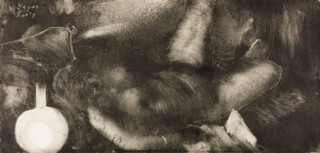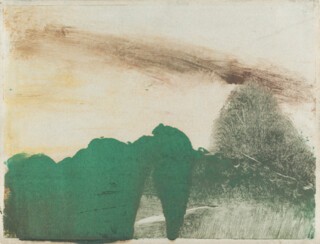Prints are defined by their reproducibility, but the monotype is self-destructive, its printable design effaced after one or two passes through a press. Since the printmaker neither etches nor engraves into the plate, but merely draws or paints directly onto its surface, the transfer of ink from plate to paper can only truly be made once (as the ‘mono’ in monotype suggests). When the ink has been transferred, the design on the plate is lost. This prevents further reproduction, beyond one or two fainter ‘cognates’ or ‘ghosts’, and perhaps a ‘counterproof’ taken from the newly printed image, from which a faint echo of the original can be made. All matrices degrade over time, even the most durable woodblocks. A copper plate can sustain as many as three thousand impressions in its lifetime. Steel plates, which came into use in the early 19th century, might wear out after printing in the tens of thousands. But the case of the self-consuming monotype, with its tiny image family of three or four, is extreme.
Edgar Degas, a ‘strategic nonbelonger’ in Carol Armstrong’s phrase, was drawn to this curious nonbelonger among print techniques. He wasn’t the first to experiment with it – Giovanni Benedetto Castiglione made monotypes in the 17th century. Yet the elective affinities between the medium’s special qualities and Degas’s artistic preoccupations gave rise to a body of work, stemming from two phases of activity, first in the mid-1870s to the 1880s and then the early 1890s, that is remarkable in the monotype’s history.
Degas came to monotype printing through his friend, the Vicomte Lepic, whose process of ‘eau-forte mobile’ could, through re-inkings of the same bitten plate, create whole new atmospheres from impression to impression. It was a short step from here to pure monotype, and Degas would produce around three hundred. He called them ‘drawings made with greasy ink and put through a press’. For his plates he used copper and zinc, but also celluloid (patented not long before as a replacement for ivory in billiard balls) and daguerreotypes with their glassy surfaces of electroplated silver. Some of the results he kept private, some were given to friends, and some exhibited. The third Impressionist Exhibition in 1877 included his monotype illustrations to Ludovic Halévy’s stories of the Paris Opéra, and eight of what Degas scholars call ‘pastelised cognates’ – pastels built up over a second-impression monotype base.
To Degas’s obsession with repetitive physical movement, and especially with the female body dancing, laundering or bathing, the monotype brought its own logic – reiterative as well as obliterative. The repetitions and rehearsals of his subjects are paralleled and enforced by the repetition inherent in the act of printing and by his subsequent reworking of the image with pastel. Take the Three Ballet Dancers (c.1878), inscribed to Alphonse Cherfils, that hangs next to its pastelised cognate, known as Ballet Scene (c.1879), in Degas: A Strange New Beauty at MoMA (until 24 July). In this ‘dark field’ monotype, three bodies in tutus emerge from a ground of black ink, rubbed and scratched into the stage light by Degas with his fingers, rags and the bristles of a dry brush. The two standing ballerinas perform an almost identical movement; the delicate flecks of their tutus fuse together. When Degas pulled the plate through his press for a second time, he produced an image cognate that is like one dancer to the next: performing the same gesture, but with a life of its own. Working over the monotype ghost with pastel, a third image emerged to obscure the second, based on the same rhythms, the same underlying map of movements, but with a new character. Now, two more dancers appear stage left, the inchoate scratches of the brush given new definition. Marks that seemed to figure the blurs and swishes of other tutus in the first impression are subsumed into the foliate green of the backcloth.
Paul Valéry wrote in 1935 that Degas’s ‘passion was to reconstruct the body of the female animal as the specialised slave of the dance, the laundry … or the streets’; the woman as ‘specialised slave’ of her repeated movements. For the dancer trained to perform the same routine over and over, the pointing of feet, arching of arms and bending of back might become automatic: movement set free from consciousness. Valéry was interested in the relationship between willed movement and the involuntary or automatic, a dynamic of labour and freedom that is central to dance, as well as to Degas’s work. Printing his drawings as monotypes introduced automatism into the process of representation; the image could be peeled apart from the work of the hand. Degas ‘dared’, Valéry wrote, ‘to try to combine the snapshot with the endless labour of the studio, enshrining the impression of it in prolonged study – the instantaneous given enduring quality by the patience of intense meditation’. As an index of a moment of repetition, the monotype enshrines the instantaneous. (Degas’s work in monotype should be considered alongside his interest in photography; a sketchbook from as early as 1860 shows that he studied photographic cartes de visite, though he didn’t make his own photographs until 1895.)
The monotype layer in so many of Degas’s pastels might also serve, as Armstrong suggests in her catalogue essay, as a kind of ‘optical unconscious’. Another cognate pair on display, Woman Reclining on Her Bed (c.1879-83), dedicated to the critic Philippe Burty, and Female Nude Reclining (c.1888-90), is a dramatic instance of transformation from monotype to pastelised version. Pastel gives the woman drapery. It slims her limbs, firms her breasts and alters the angle of her body, making it less weighty, less obscure, more available. It softens the white orb of the gas light, effaces the scratched sparks of light. The fingerprints that register Degas’s own bodily presence disappear. Yet the visible plate mark in the extended pastel is a reminder of the far darker image below. Starker still is the juxtaposition of Woman in a Bathtub and Woman in Her Bath, Sponging Her Leg (both c.1880-85). The woman in the pure monotype (dedicated to another of Degas’s male friends) hunches forward, neckless and caricatural, to scratch her leg. Swan-like bath taps arc as if to dip their beaks in the water. They disappear in the pastel version, which gives the room daylight and pretty wallpaper, and the woman a sponge, a neck, cheekbones, a chignon.
Degas’s critics called him a ‘cruel’ artist. ‘M. Degas, who in his admirable pictures of dancers, had already so implacably rendered the decadence of the mercenary dulled by her mechanical frolics and monotonous leaps, brought this time to his series of nudes an attentive cruelty, a patient hatred,’ Huysmans wrote of works exhibited in 1886. Nothing could better encapsulate that cruelty than these fire and gaslight monotypes of faceless, naked, and in one case brutally upturned, bodies. They are among the most austere, and at the same time the most virtuosic, images Degas produced. The so-called dark field bathers are a world away from the daytime of the landscape monotypes in the exhibition. Airless interiors eked out of black ink give way to outdoor views printed from coloured oil paint, as abstract as Turner’s ‘colour beginnings’. From The Fireside (c.1880-85), you can look across the aisle to Forest in the Mountains (c.1890), one of a number of landscapes resulting from Degas’s visit to his friend Georges Jeanniot in the Burgundy countryside and shown at Durand-Ruel’s gallery in 1892. Degas revelled in the contingency of printing blots of paint, giving these chance shapes a topographical legibility that co-exists with their obstinate formlessness: look at the great green spill in Forest in the Mountains. ‘Nothing in art should resemble an accident,’ Degas declared, ‘even movement.’
It is difficult to relate these startlingly different monotype groups to one another, but their placement at MoMA courts the question. Richard Kendall once suggested the connection between the landscapes and the nudes lay in the former’s anthropomorphism: the female body as the optical unconscious of landscape. He was not the first to posit a relationship between the Burgundy monotypes and Degas’s women. ‘Degas is still resolutely Degas faced with fields, hills, water, skies,’ Gustave Geffroy wrote in 1894. ‘These hills, these fields, are of a weft as luxurious as fabric, as curtains, as tapestries that clothe the walls of secret boudoirs, like heavy robes that hide the solid bodies of resting women … Here and there, everywhere, colours are scorched by light, fading into greenish flames, falling into the remnants of embers and rosy ashes.’ Embers and ashes take us back not just to the boudoir’s fireside, but also to the idea of the image consuming itself, burning up, like the mark on the monotype plate, in its own expression.
Send Letters To:
The Editor
London Review of Books,
28 Little Russell Street
London, WC1A 2HN
letters@lrb.co.uk
Please include name, address, and a telephone number.



